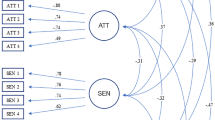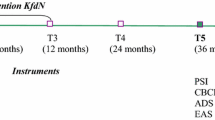Abstract
The present follow-up study examined the contribution of early temperament to mental health in preschool and school years. Participants represent a community sample of 96 children (54% female) from urban and rural areas of Russia. Temperament was measured by the Infant Behavior Questionnaire-Revised and the Early Childhood Behavior Questionnaire; mental health was assessed using the Strengths and Difficulties Questionnaire. Effortful control and negative affectivity accounted for 17% of the variance in internalizing problems and 6% in externalizing problems, and results also highlighted the contribution of lower-order traits. Our findings emphasize the importance of broadband and fine-grained early temperamental traits for later mental health in the Russian context and support the predominant role of effortful control and negative affectivity.



Similar content being viewed by others
References
Abulizi, X., Pryor, L., Michel, G., Melchior, M., Van Der Waerden, J., & on behalf of The EDEN Mother–Child Cohort Study Group. (2017). Temperament in infancy and behavioral and emotional problems at age 5.5: The EDEN mother-child cohort. PLoS One, 12, e0171971. https://doi.org/10.1371/journal.pone.0171971.
Achenbach, T. M., & Rescorla, L. (2007). Multicultural understanding of child and adolescent psychopathology: Implications for mental health assessment. New York: Guilford Press.
Arbuckle, J. L. (2008). Amos 17.0 user’s guide. Chicago: SPSS Inc.
Aron, E. N., Aron, A., & Davies, K. M. (2005). Adult shyness: The interaction of temperamental sensitivity and an adverse childhood environment. Personality and Social Psychology Bulletin, 31(2), 181–197. https://doi.org/10.1177/2F0146167204271419.
Belsky, J., & Pluess, M. (2009). Beyond diathesis-stress: differential susceptibility to environmental influences. Psychological Bulletin, 135, 885–908 http://psycnet.apa.org/doi/10.1037/a0017376.
Bridgett, D. J. (2008). Temperament development and early temperament predictors of psychopathology: examination of developmental trajectories of increased temperament risk for psychopathology and the direct and indirect effects of infant temperament on toddler psychopathology outcomes (Doctoral dissertation, Washington State University).
Copeland, W. E., Angold, A., Shanahan, L., & Costello, E. J. (2014). Longitudinal patterns of anxiety from childhood to adulthood: the Great Smoky Mountains study. Journal of the American Academy of Child & Adolescent Psychiatry, 53(1), 21–33. https://doi.org/10.1016/j.jaac.2013.09.017.
Costello, E. J., & Maughan, B. (2015). Annual research review: optimal outcomes of child and adolescent mental illness. Journal of Child Psychology and Psychiatry, 56(3), 324–341. https://doi.org/10.1111/jcpp.12371.
DeLisi, M., & Vaughn, M. G. (2014). Foundation for a temperament-based theory of antisocial behavior and criminal justice system involvement. Journal of Criminal Justice, 42(1), 10–25. https://doi.org/10.1016/j.jcrimjus.2013.11.001.
Dougherty, L. R., Klein, D. N., Durbin, C. E., Hayden, E. P., & Olino, T. M. (2010). Temperamental positive and negative emotionality and children's depressive symptoms: a longitudinal prospective study from age three to age ten. Journal of Social and Clinical Psychology, 29(4), 462–488. https://doi.org/10.1521/jscp.2010.29.4.462.
Eisenberg, N., Spinrad, T. L., Fabes, R. A., Reiser, M., Cumberland, A., Shepard, S. A., Valiente, C., Losoya, S. H., Guthrie, I. K., & Thompson, M. (2004). The relations of effortful control and impulsivity to children’s resiliency and adjustment. Child Development, 75(1), 25–46. https://doi.org/10.1111/j.1467-8624.2004.00652.x.
Eisenberg, N., Sadovsky, A., Spinrad, T. L., Fabes, R. A., Losoya, S. H., Valiente, C., ... & Shepard, S. A. (2005). The relations of problem behavior status to children's negative emotionality, effortful control, and impulsivity: concurrent relations and prediction of change. Developmental Psychology, 41(1), 193. https://doi.org/10.1037/0012-1649.41.1.193.
Eisenberg, N., Valiente, C., Spinrad, T. L., Cumberland, A., Liew, J., Reiser, M., ... & Losoya, S. H. (2009). Longitudinal relations of children’s effortful control, impulsivity, and negative emotionality to their externalizing, internalizing, and co-occurring behavior problems. Developmental Psychology, 45(4), 988–1008. https://doi.org/10.1037/a0016213.
Eisenberg, N., Taylor, Z. E., Widaman, K. F., & Spinrad, T. L. (2015). Externalizing symptoms, effortful control, and intrusive parenting: a test of bidirectional longitudinal relations during early childhood. Development and Psychopathology, 27(4pt1), 953–968. https://doi.org/10.1017/S0954579415000620.
Gartstein, M. A., & Rothbart, M. K. (2003). Studying infant temperament via a revision of the infant behavior questionnaire. Journal of Infant Behavior and Development, 26, 64–86.
Gartstein, M. A., Slobodskaya, H. R., & Kinsht, I. A. (2003). Cross-cultural differences in temperament in the first year of life: United States of America (U.S.) and Russia. International Journal of Behavioral Development, 27, 316–328. https://doi.org/10.1080/01650250244000344.
Gartstein, M. A., Knyazev, G. G., & Slobodskaya, H. R. (2005). Cross-cultural differences in the structure of infant temperament: United States of America (U.S.) and Russia. Infant Behavior and Development, 28, 54–61. https://doi.org/10.1080/01650250244000344.
Gartstein, M. A., Putnam, S. P., & Rothbart, M. K. (2012). Etiology of preschool behavior problems: contributions of temperament attributes in early childhood. Infant Mental Health Journal, 33(2), 197–211. https://doi.org/10.1002/imhj.21312.
Gartstein, M. A., Slobodskaya, H. R., Kirchhoff, C., & Putnam, S. P. (2013). Cross-cultural differences in the development of behavior problems: contributions of infant temperament in Russia and US. International Journal of Developmental Science, 7, 95–104. https://doi.org/10.3233/DEV-1312104.
Gartstein, M. A., Putnam, S. P., Aron, E. N., & Rothbart, M. K. (2016). Temperament and personality. In S. Matzman (Ed.), Oxford handbook of treatment processes and outcomes in counseling psychology (pp. 11–41). New York: Oxford University Press.
Goodman, R. (2001). Psychometric properties of the strengths and difficulties questionnaire. Journal of the American Academy of Child and Adolescent Psychiatry, 40, 1337–1345. https://doi.org/10.1097/00004583-200111000-00015.
Goodman, R., & Scott, S. (2012). Child and adolescent psychiatry. Oxford: Wiley-Blackwell.
Goodman, R., Slobodskaya, H., & Knyazev, G. (2005). Russian child mental health a cross-sectional study of prevalence and risk factors. European Child and Adolescent Psychiatry, 14, 28–33. https://doi.org/10.1007/s00787-005-0420-8.
Hoyle, R. H. (1995). Structural equation modeling: concepts, issues, and applications. London: Sage.
Kolmagorova, А. V., Slobodskaya, H. R., & Gartstein, M. A. (2008). A Russian adaptation of the Early Childhood Behavior Questionnaire (ECBQ) for measuring temperament. Psikhologicheskii Zhurnal, 29, 82–97 (In Russian).
Lee H. (2017). The moderating effects of maternal behaviors on infant fine-grained temperament in the development of toddler behavior problems (Doctoral dissertation, Seoul National University).
Lengua, L. J. (2003). Associations among emotionality, self-regulation, adjustment problems, and positive adjustment in middle childhood. Journal of Applied Developmental Psychology, 24(5), 595–618. https://doi.org/10.1016/j.appdev.2003.08.002.
Leve, L. D., Kim, H. K., & Pears, K. C. (2005). Childhood temperament and family environment as predictors of internalizing and externalizing trajectories from ages 5 to 17. Journal of Abnormal Child Psychology, 33(5), 505–520. https://doi.org/10.1007/s10802-005-6734-7.
Mash, E. J., & Wolfe, D. A. (2010). Abnormal child psychology. Belmont: Wadsworth CENGAGE Learning.
Moffitt, T. E., Arseneault, L., Belsky, D., Dickson, N., Hancox, R. J., Harrington, H., ... & Sears, M. R. (2011). A gradient of childhood self-control predicts health, wealth, and public safety. Proceedings of the National Academy of Sciences, 108(7), 2693–2698. https://doi.org/10.1073/pnas.1010076108.
Neumann, A. A., Iverson, S. L., Kelly, S., Rosen, I. M., Biermann, A. L., & Gartstein, M. A. (2016, October). Knowing Your Baby Matters: A temperament education intervention study. Presentation at the 21st meeting of the Occasional Temperament Conference, Seattle.
Northerner, L. M., Trentacosta, C. J., & McLear, C. M. (2016). Negative affectivity moderates associations between cumulative risk and at-risk toddlers’ behavior problems. Journal of Child and Family Studies, 25(2), 691–699. https://doi.org/10.1007/s10826-015-0248-x.
Oldenhinkel, A. J., Hartman, C. A., De Winter, A. F., Veentra, R., & Ormel, J. (2004). Temperament profiles associated with internalizing and externalizing problems in adolescence. Development and Psychopathology, 16, 421–440.
Putnam, S. P., Ellis, L. K., & Rothbart, M. K. (2001). The structure of temperament from infancy through adolescence. In A. Eliasz & A. Angleitner (Eds.), Advances/proceedings in research on temperament (pp. 165–182). Lengerich: Pabst Scientist Publisher.
Putnam, S. P., Gartstein, M. A., & Rothbart, M. K. (2006). Measurement of fine-grained aspects of toddler temperament: the early childhood behavior questionnaire. Infant Behavior and Development, 29, 386–401. https://doi.org/10.1016/j.infbeh.2006.01.004.
Putnam, S. P., Rothbart, M. K., & Gartstein, M. A. (2008). Homotypic and heterotypic continuity of fine-grained temperament during infancy, toddlerhood, and early childhood. Infant and Child Development, 17, 387–405. https://doi.org/10.1002/ICD.582.
Rothbart, M. K. (2007). Temperament, development and personality. Current Directions in Psychological Science, 16, 207–212. https://doi.org/10.1111/j.1467-8721.2007.00505.x.
Rothbart, M. K., & Bates, J. E. (2006). Temperament. In W. Damon, R. Lerner, & N. Eisenberg (Eds.), Handbook of child psychology: vol. 3. Social, emotional, and personality development (6th ed., pp. 99–166). New York: Wiley.
Rothbart, M. K., & Derryberry, D. (1981). Development of individual differences in temperament. In M. E. Lamb & A. L. Brown (Eds.), Advances in developmental psychology (Vol. Vol.1, pp. 37–86). Hillsdale: Erlbaum.
Rutter, M. J., Bishop, D., Pine, D., Scott, S., Stevenson, J. S., Taylor, E. A., & Thapar, A. (2011). Rutter’s child and adolescent psychiatry. Oxford: Blackwell.
Silk, J. S., Shaw, D. S., Forbes, E. E., Lane, T. L., & Kovacs, M. (2006). Maternal depression and child internalizing: the moderating role of child emotion regulation. Journal of Clinical Child and Adolescent Psychology, 35(1), 116–126. https://doi.org/10.1207/s15374424jccp3501_10.
Slobodskaya, H. R., & Akhmetova, O. A. (2010). Personality development and problem behavior in Russian children and adolescents. International Journal of Behavioral Development, 34, 441–451. https://doi.org/10.1177/0165025409352825.
Slobodskaya, H. R., Gartstein, M. A., Nakagawa, A., & Putnam, S. P. (2013). Early temperament in Japan, the United States US and Russia: do cross-cultural differences decrease with age? Journal of Cross-Cultural Psychology, 44, 438–460. https://doi.org/10.1177/0022022112453316.
Sourander, A., Chudal, R., Skokauskas, N., Al-Ansari, A. M., Klomek, A. B., Pornnoppadol, C., ... & Kaneko, H. (2018). Unmet needs of child and adolescent psychiatrists among Asian and European countries: does the Human Development Index (HDI) count? European Child & Adolescent Psychiatry, 27(1), 5–8. https://doi.org/10.1007/s00787-017-1095-7.
Tackett, J. L. (2006). Evaluating models of the personality–psychopathology relationship in children and adolescents. Clinical Psychology Review, 26(5), 584–599. https://doi.org/10.1016/j.cpr.2006.04.003.
Tremblay, R. E. (2010). Developmental origins of disruptive behaviour problems: the ‘original sin’ hypothesis, epigenetics and their consequences for prevention. Journal of Child Psychology and Psychiatry, 51(4), 341–367. https://doi.org/10.1111/j.1469-7610.2010.02211.x.
Visser, A., Huizinga, G. A., Hoekstra, H. J., van der Graaf, W. T., & Hoekstra-Weebers, J. E. (2007). Temperament as a predictor of internalising and externalising problems in adolescent children of parents diagnosed with cancer. Supportive Care in Cancer, 15(4), 395–403. https://doi.org/10.1007/s00520-006-0117-7.
Wang, F. L., Chassin, L., Eisenberg, N., & Spinrad, T. L. (2015). Effortful control predicts adolescent antisocial-aggressive behaviors and depressive symptoms: co-occurrence and moderation by impulsivity. Child Development, 86(6), 1812–1829. https://doi.org/10.1111/cdev.12406.
Acknowledgments
The authors thank the participating parents and their children who participated in the study and colleagues who collected parts of the data.
Funding
This study was funded by the Russian Scientific Foundation (grant number 16-18-00003; data analyses) and the Russian Foundation for Basic Research (grant number 19-013-00034; manuscript preparation).
Author information
Authors and Affiliations
Corresponding author
Ethics declarations
Conflict of Interest
The authors declare that they have no conflict of interest.
Ethical Approval
All procedures performed in this study involving human participants were in accordance with the ethical standards of the Institute of Physiology and Basic Medicine ethics committee and with the 1975 Helsinki Declaration.
Informed Consent
Written informed consent was obtained from all participating parents included in the study and they received both written and verbal information about study aims and procedures.
Additional information
Publisher’s Note
Springer Nature remains neutral with regard to jurisdictional claims in published maps and institutional affiliations.
Rights and permissions
About this article
Cite this article
Kozlova, E.A., Slobodskaya, H.R. & Gartstein, M.A. Early Temperament as a Predictor of Child Mental Health. Int J Ment Health Addiction 18, 1493–1506 (2020). https://doi.org/10.1007/s11469-019-00181-3
Published:
Issue Date:
DOI: https://doi.org/10.1007/s11469-019-00181-3




